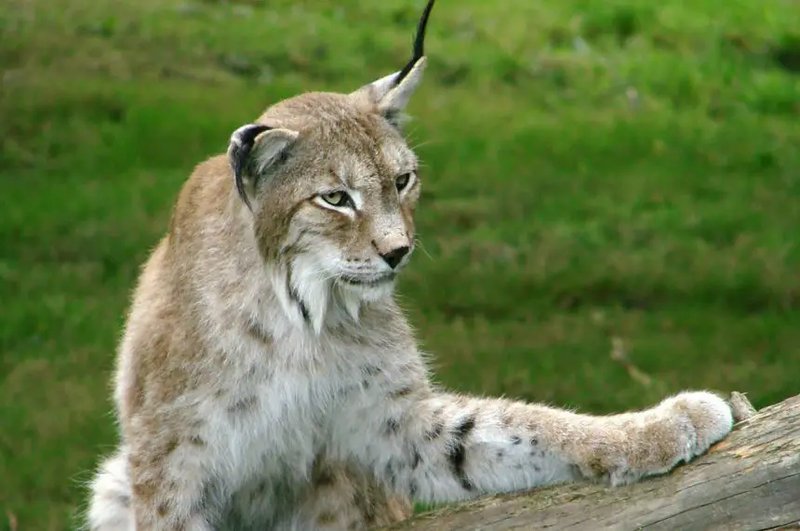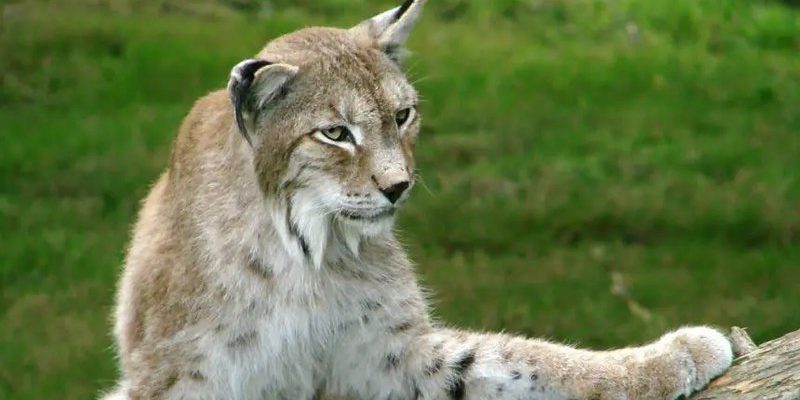
In this article, we’ll explore ten animals similar to the Eurasian lynx—from other lynxes to different wild cats. Whether you’re an animal lover, a trivia buff, or just someone who enjoys learning new things over coffee, this is the perfect way to dive into the feline family tree. We’ll cover how these animals look, their habitats, and what makes each one unique. So, let’s get started!
1. Canada Lynx
The Canada lynx is probably the most well-known relative of the Eurasian lynx. These two species are quite similar in appearance, boasting fluffy fur, long legs, and that iconic tufted ear. The Canada lynx, however, is smaller and primarily found in North America. They thrive in dense forests, especially those filled with snowshoe hares, their favorite snack.
You might be wondering how to tell them apart. While both lynxes have a similar body shape, the Canada lynx has larger paws proportionately to help them walk on snow without sinking. Plus, their fur is often lighter, almost grayish, compared to the tawny coat of the Eurasian lynx.
Key differences:
- Size: Canada lynx is typically smaller.
- Paw size: Bigger paws for snow navigation.
- Color: Lighter fur compared to the Eurasian lynx.
2. Iberian Lynx
Next up is the Iberian lynx, a rare gem found in the Iberian Peninsula in Spain and Portugal. This lynx is slightly smaller than the Eurasian lynx and has distinctive spots on its coat that help it blend into its Mediterranean habitat. The Iberian lynx is critically endangered, which makes spotting one in the wild an extraordinary rarity.
What truly sets this lynx apart is its broader face and shorter legs, giving it a unique silhouette. Their diet primarily includes European rabbits, which are becoming scarce, putting this beautiful cat at risk. If you’re ever in the Iberian Peninsula and catch a glimpse of one, consider yourself lucky!
Key differences:
- Habitat: Found in the Iberian Peninsula.
- Diet: Primarily eats rabbits.
- Body shape: Broader face and shorter legs.
3. Bobcat
The bobcat might not look exactly like the Eurasian lynx, but they share enough in common to be worth mentioning. Bobcats are smaller and have a more spotted coat, but their tufted ears and general body structure reflect that lynx heritage. They are incredibly adaptable and can be found across North America in varied habitats, from forests to deserts.
These cats are often seen as more elusive than their larger cousins. One fascinating fact about bobcats is their ability to adapt to urban environments. It’s not uncommon to hear reports of them wandering into suburban backyards, much to the surprise of homeowners.
Key differences:
- Size: Smaller than the Eurasian lynx.
- Coat pattern: More spots and stripes.
- Habitat: Highly adaptable, found in urban areas.
4. Serval
Now let’s talk about the serval. This stunning cat is native to Africa and stands out with its long legs and large ears. While not a lynx, the serval has a similar body shape and is also known for its agility. They can leap high to catch birds and small mammals, showcasing incredible hunting skills.
In contrast to the lynx, servals typically have a golden coat with black spots. Their long limbs give them a tall, elegant appearance, perfect for stalking through the tall grasses of the savannah. If you ever see a serval in action, you’ll certainly be captivated by its gracefulness.
Key differences:
- Location: Native to Africa.
- Body shape: Longer legs compared to lynx.
- Coat color: Golden with black spots.
5. Caracal
Another African cat, the caracal, is often confused with the lynx due to its tufted ears and similar size. Caracals are renowned for their incredible jumping ability and can leap up to 10 feet in the air to catch birds in flight, which is pretty impressive!
In terms of appearance, they have a reddish-tan coat and a more streamlined body. Unlike the Eurasian lynx, their face is more elongated, and they lack the characteristic short tail. These cats are solitary and prefer to hunt at night, making them masterful nocturnal predators.
Key differences:
- Location: Also found in Africa and parts of the Middle East.
- Tail: Longer than a lynx’s.
- Color: Reddish-tan coat.
6. Ocelot
Moving over to South America, the ocelot is a small wild cat with striking fur patterns that resemble those of a lynx. Ocelots have beautiful spots and stripes, which provide excellent camouflage in their forested habitats.
While similar in size to a lynx, ocelots are generally more slender. They tend to have a more varied diet, feeding on small mammals, birds, and even reptiles. Spotting an ocelot in the wild is quite the treat, as they are known for their elusive nature.
Key differences:
- Habitat: Found in tropical forests of South America.
- Diet: More varied, including reptiles.
- Coat pattern: More pronounced spots and stripes.
7. Jungle Cat
The jungle cat is native to the Middle East and parts of Asia. With a more slender build and longer legs than the Eurasian lynx, this cat often hangs out near water and is an excellent swimmer. They have short fur, which is typically a sandy or grayish color and tends to blend into their environment seamlessly.
Although they don’t have the tufted ears that characterize lynxes, they do have a similar overall shape. Jungle cats are nocturnal and prefer hunting small mammals, birds, and fish, making them quite versatile in their hunting strategies.
Key differences:
- Habitat: Lives near water sources in Asia.
- Color: Sandy or grayish coat.
- Swimming ability: Excellent swimmers.
8. Fishing Cat
The fishing cat is another water-loving relative that hails from Southeast Asia. This cat is a bit bulkier than the Eurasian lynx and, as the name suggests, has a diet that heavily revolves around fish. They have webbed feet, which make them exceptional swimmers, a feature not found in other lynx species.
These cats have a distinctive coat with dark spots and stripes, providing them with great camouflaging abilities in their wetland habitats. If you’re ever near a wetland area in Asia, keep an eye out; you might just see a fishing cat wading through the water.
Key differences:
- Location: Found in wetland areas in Southeast Asia.
- Diet: Primarily eats fish.
- Body structure: Bulkier with webbed feet.
9. Asian Golden Cat
The Asian golden cat is a medium-sized wild cat that can be mistaken for a lynx at first glance. It’s found in Southeast Asia and has a beautiful golden coat, often with faint spots. These cats are solitary and adept hunters, preying on various animals ranging from small mammals to birds.
What sets them apart from the Eurasian lynx is their sleek appearance and smaller size. They also lack those tufted ears that have become synonymous with lynxes, making the Asian golden cat unique in its own right.
Key differences:
- Habitat: Found in forests across Southeast Asia.
- Color: Golden coat with faint spots.
- Size: Smaller and sleeker.
10. Pallas’s Cat (Manul)
Last but not least, we have the Pallas’s cat, also known as the manul. This unique little cat is native to the grasslands and steppes of Central Asia. While it’s significantly smaller than the Eurasian lynx, its stout body and long fur give it a somewhat similar appearance.
What makes Pallas’s cat stand out is its round face and wide-set eyes, which make it look incredibly adorable. These cats are highly adapted to their harsh environments and can withstand cold temperatures quite well. Although they don’t rival the lynx in size or hunting prowess, their quirky appearance and behavior make them fascinating.
Key differences:
- Size: Much smaller than the Eurasian lynx.
- Facial features: Round face and wide-set eyes.
- Habitat: Lives in grasslands of Central Asia.
Wrapping Up
Exploring the fascinating world of animals similar to the Eurasian lynx has opened a window into the rich diversity of wild cats. Each species we talked about has its own unique traits, adaptations, and habitats. Whether it’s the larger Canada lynx or the adorable Pallas’s cat, these animals remind us of nature’s creativity.
As you continue to learn about these incredible creatures, keep an eye out for any opportunities to spot them in the wild or in conservation areas. The more we know about them, the better we can appreciate their role in the ecosystem and help protect their habitats. So, the next time you picture a lynx, remember there’s a whole family of fascinating felines out there, each with its own story to tell.

